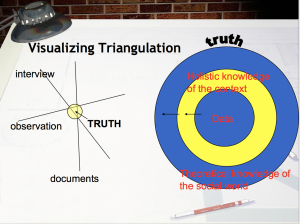A key strategy for establishing the veracity of interpretive/critical research is triangulation. The term is over-used and often mis-used. Many researchers imply that triangulation will lead to the truth by eliminating bias and is not based on the presumption that there is indeed a single truth to be gotten to (image on the left), but in reality the value of triangulation is more nuanced. Sometimes, data from different sources or collected by different methods do converge, but often they are inconsistent or even contradictory. Convergence is not more analytically useful (or closer to the truth) than inconsistence or contradiction. Triangulation provides the researcher with rich data from which to discern meaning, but this is a task for the researcher not an inevitable result of using a technique (image on the right). For a more thorough discussion of what this means and some examples, click on the article link below.

 Follow
Follow

Thank you Sandra,
This article did help to explain the value of triangulation. It was originally explained to me for the purpose of making my work more valid and defensible. I now understand that triangulation is not so much about finding convergence as it is developing a more complete understanding of the phenomenon under study.
Thanks again.
P.S. I think that a couple illustrations showing the different conceptualizations of triangulation (similar to what you sketched in class) would be very helpful .